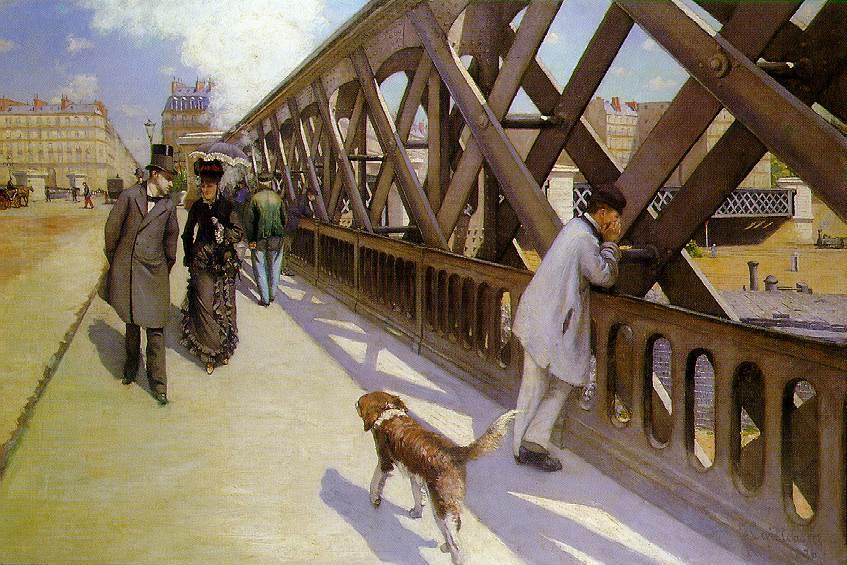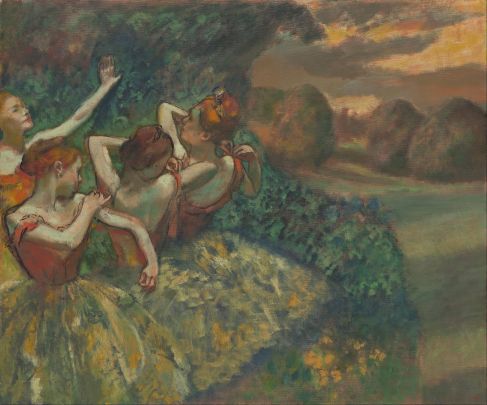The Floor Scrapers – 1875
The artistic career of Gustave Caillebotte (1848–1894) began with failure. In 1875 the jury of the Salon, the French government’s elite art exhibition held annually in Paris, rejected his submission, The Floor Scrapers (fig. 1). Painted earlier that year, Caillebotte’s picture of shirtless, working-class men hand-planing wood foors did not appeal to the conservative sensibilities of the jurors, who were confounded by its unheroic—even “vulgar”—subject matter and unsettling perspective. Although his depiction of modern urban life put off the Salon jury, it caught the eye of several impressionist painters, who persuaded Caillebotte to join the group’s second exhibition the following year. Displayed in that venue alongside paintings by Edgar Degas, Auguste Renoir, Alfred Sisley, and Claude Monet, Caillebotte’s work garnered considerable critical attention—both positive and negative. It was not only praised for being “excessively original” and a “faithful representation of life,” but also criticized for its unidealized subject, prompting one reviewer to declare, “Do nudes, but do beautiful nudes, or don’t do them at all.”
Over the course of the next six years, Caillebotte became a vital member of the impressionist circle, exhibiting with them and partaking in their aesthetic exchange, as well as devoting his time, energy, and money to helping them organize exhibitions. His secure fnances, owing to his family’s successful textile business, also enabled Caillebotte to purchase works by his friends and become a major patron of the group. These were intensely productive years, as Caillebotte and his colleagues forged new artistic currents that brought French art surging into the modern era. For the impressionists, no subject was too banal for the canvas: Parisians strolling along a crowded street, workers painting a building, a couple reading in their living room, and even sidewalk grates were as valid as the religious, mythological, and historical subjects prized by the academy. The transitory effects of color and light also became a popular subject amongst the group, who affronted traditionalists with their bold brushstrokes and brazen palette. Equally arresting was their use of innovative perspectives, including unusual vantage points, cropped fgures, and a fattened picture plane. Unlike traditional academic painters who favored posed, carefully framed, static compositions, the impressionists sought to capture feeting moments and the skewed and haphazard ways of seeing experienced in daily life. Caillebotte shared many of these impressionist concerns. His Interior, Woman at the Window (fig. 2), for example, features a man and woman within a compressed space, their physical proximity in sharp contrast to their emotional distance. The man, seated in an armchair, is absorbed in his newspaper while the woman stands before the window and gazes at the boulevard below, equally consumed by her own thoughts. Across the street at the Hotel Canterbury, another fgure, glimpsed through parted curtains, watches the woman. It is a picture that suggests loneliness, isolation, and desire, but most signifcantly, perhaps, it is about vision and looking, where an indeterminate narrative of stolen glances and steady observation plays out across the Parisian boulevard.
 Interior, Woman at the Window 1880
Interior, Woman at the Window 1880
Throughout Caillebotte’s oeuvre the theme of vision and looking persists. Figures are seen gazing across cafés and from balconies, bridges, and overstuffed sofas. Caillebotte often implied the presence of a voyeur by positioning us, the viewers, as though we were in the midst of the scene—looking across a dining table, out an apartment window, or down the street—and then painting from our vantage point. His many still-life paintings, lesser known than his cityscapes, similarly explore themes of vision, but through the art of commercial display. They show the seductions of Parisian markets—the butcher shops, pâtisseries, and produce stands—with comestibles beautifully presented to lure customers. A potpourri of lushly colored fruit flls nearly every inch of Fruit Displayed on a Stand, where white paper cradles each fg, pear, apple, orange, and tomato, and verdant leaves frame the arrangement. The carefully constructed display is designed to tempt passersby and turn a proft. Caillebotte’s interest in such storefront displays signals his prescient understanding of the bond between modern vision and consumerism, between open eyes and open wallets.
Fruit Displayed On A Stand 1881 – 1882
Many of the works on view at the impressionist exhibitions were remarkable for their loose brushwork and unmixed colors, giving critics the sense that they were unfnished studies or mere impressions rather than fully realized paintings. By comparison, Caillebotte’s canvases were notable for their tighter handling of paint and subdued palette, which imparted to his canvases a more structured and less spontaneous feel. In The Pont de l’Europe, for instance, the crisp lines evident in the geometric precision of the girders and railing extend to the fgures and shadows, each of which is self-contained within clearly demarcated borders. Only in the plumes of steam and clouds and the dog’s fur (and quite subtly in the modeling of the street and sidewalk) did Caillebotte permit himself looser brushwork. Paris Street, Rainy Day (cover) refects a similar rigor in the handling of the brush. In both paintings, the artist explored the new spaces of a city profoundly transformed by the urban renovations guided by Baron Haussmann beginning in the 1850s. These improvements addressed a host of ills, including poor sanitation, traffc congestion, crowded streets, nighttime perils, and political unrest, by comprehensively modernizing central Paris. The two paintings profle the capital’s new look, with its now iconic wide boulevards, ample sidewalks, and uniform buildings.

Pont de l’Europe 1876
When Paris Street, Rainy Day was exhibited at the 1877 impressionist exhibition, it elicited numerous comparisons to photography, calling to mind the wide angles, deep focus, and severe cropping of fgures seen in the new medium. Caillebotte carefully composed the painting, using the lamppost to bifurcate the canvas and positioning the umbrellas and lines of perspective to draw our eyes from the foreground to the deep recesses. Nonetheless, the composition maintains a certain degree of haphazardness. The foreground fgures look like they might collide while a pair of disembodied legs pokes out from an umbrella, as if the artist stumbled upon this particular scene and set out to faithfully duplicate it, much like a photographer taking a snapshot.
Paris Street, Rainy Day
After his last showing with the impressionists in 1882, Caillebotte ceased to exhibit regularly, and by decade’s end he had moved from Paris to the suburbs, further distancing himself from cultural developments in the capital. He had grown up spending time outside the city, regularly visiting his family’s riverside property in Yerres, ffteen miles south of Paris, and painting a number of boating pictures. In them he had experimented with livelier brushstrokes and a more vivid palette, as seen in Boating on the Yerres, where refections of blue, green, yellow, and white skip across the river.

After the family estate was sold, Caillebotte purchased in 1881 his own suburban retreat in Petit Gennevilliers, north of Paris along the banks of the Seine. There he dedicated himself to painting landscapes, which had always been a passion of his as a collector but previously held little interest to him as an artist. The shift may also have been an indicator of his increasingly close friendship with Monet, who was devoted to landscape painting, frst in suburban Argenteuil and then in more rural Giverny. A series of depictions of the felds near Caillebotte’s home shows his willingness to jettison the tight handling of his work from the previous decade. Although the compositions maintain an underlying geometry, the application of the paint is heavier, the brushstrokes are less inhibited, and the colors more daring.

Fields
In the fnal decade of his life, which was cut short by a stroke in 1894, other interests surpassed his artistic endeavors. The number of canvases he produced dwindled as he made time to collect stamps, tend to his fowers, design sailboats, and compete in regattas. Upon his death, much of his sizable art collection—including masterpieces by Degas, Monet, Renoir, and others— was willed to the state, becoming the cornerstone of France’s national collection of impressionism. This bequest was so impressive that it overshadowed his reputation as an artist. Caillebotte, who had never needed to turn a proft from his painting, did not sell his works and thus, ironically, relatively few of his own paintings have entered public collections. With his art shielded from public view, his signifcant role in the development of impressionism further receded and he remained largely undetected until later in the twentieth century when a series of exhibitions focused on Caillebotte. One of the pleasures of this exhibition is that we remain in the incipient stages of this rediscovery. Providing a rare opportunity to view together his greatest works, culled from private lenders and public institutions, Gustave Caillebotte: The Painter’s Eye allows us to further consider the artistic innovations and role of this relatively unknown impressionist
Click to access caillebotte-brochure.pdf
Skiffs on the Yerres

























